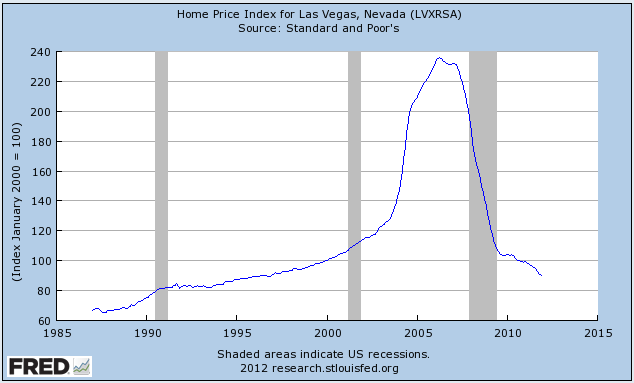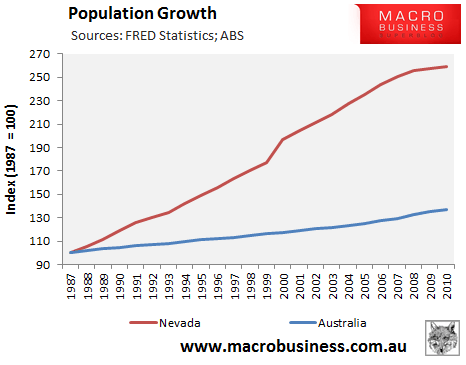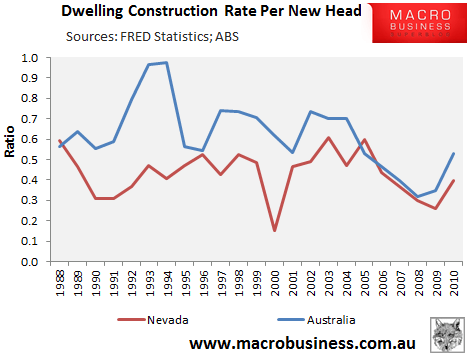By Leith van Onselen
The above YouTube video shows spectacular satellite footage of Las Vegas’ rapid urban growth since the early-1970s.
Las Vegas is home to one of the world’s largest housing bubbles/busts, whereby house prices rose sharply in the decade to 2007 before plunging more than 60% in the years following (see below chart).

Many commentators attribute Las Vegas’ huge house price crash to a combination of lax lending and a significant oversupply of homes. While the former is true, the claim that Las Vegas built too many homes in the lead-up to the crash is highly debatable.
For starters, Nevada (home of Las Vegas) was the fastest growing state in the United States, experiencing population growth of 160% between 1987 and 2010. This compares to 37% growth in Australia’s population over the same period (see below chart).

Contrary to popular belief, the rate of new home construction, when compared against population growth, was also lower in Las Vegas than Australia in the 23 years to 2010 (see below chart).
Like Australia, land constraints and ‘housing shortage’ arguments were present in the Las Vegas bubble. The federal government Bureau of Land Management (BLM), which owns around 90% of the land in Clark County, which contains the entire Las Vegas urban area, heavily restricted the quantity of land available for development in Las Vegas in an effort to maximise revenues, causing builders and developers to bid-up land price in period auctions to ensure their supply of land for construction (called ‘land banking’).
Whereas the price of land for housing generally sold for $40,000 per acre in the late 1990s, toward the peak of the bubble, average land prices fetched ten times that amount. Obviously, this land price inflation was a principal cause of the house price escalation as well as the sluggish supply response to the rapidly growing population and rising house prices.
An article published in late 2006 in USA Today explains the supply situation in Las Vegas well:
LAS VEGAS — Flying into this desert metropolis is as deceiving as a mirage. From 10,000 feet you see empty land in all directions and swear the pace of suburban sprawl could go on unchecked.You’d swear no end’s in sight to subdivisions stretching for miles beyond the Strip, enclaves of single-family houses that draw thousands of Californians and other migrants a year.
Look again. The valley that Las Vegas and 1.8 million residents call home is nearly built out. Mountains, national parks, military bases, an Indian community and a critter called the desert tortoise have Sin City hemmed in. At the current building pace in the USA’s fastest-growing major metro area, available acreage will be gone in less than a decade, developers and real estate analysts say.
Yet growth pressure and housing demand won’t abate. Greater Las Vegas will add 1 million residents in the next 10 years, state estimates say, and hit 3 million by 2020.
“You hear anywhere from a seven to 10 years supply at our growth rates and the valley’s full,” says developer Kenneth Smith of Glen, Smith and Glen…
A scarcity of land — or just as important, says Hal Rothman, a University of Nevada-Las Vegas history professor, the perception that it’s scarce — is driving prices skyward. “The result was a rush,” he says. “The situation is making a new valley around us, one that will be more crowded and expensive.”
Developers who 15 years ago paid less than $40,000 an acre are paying more than $300,000 today. In an auction of public land that went on the market last year, a developer paid $639 million for 2,655 acres…
Developers are leapfrogging over BLM land with plans for big projects, such as 42,000-acre Coyote Springs 50 miles north of here. That’s “drive until you qualify” territory for home buyers seeking affordable mortgages. But costs of building roads, sewers and utilities “are incredible,” says Steve Bottfeld, senior analyst of Marketing Solutions, a local research firm. “Don’t look for it to happen in 10 years”…
Developers don’t expect land prices to fall. They’re packing houses in traditional subdivisions so close together neighbors can practically shake hands out their windows. Economics are moving developers toward a slow embrace of trends familiar elsewhere…
The Las Vegas experience is a salutary lesson for those mounting the argument that Australia’s housing shortage and land supply constraints will prevent home prices from falling. Bigger house price booms caused by easy credit meeting restricted supply inevitably increases the risk of price volatility on the upside and down.


